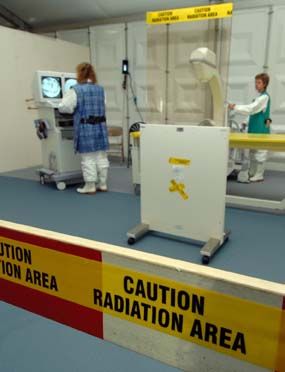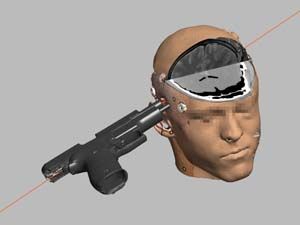Forensic imaging specialists put their case for mainstream recognition
Forensic radiography sessions have become a fixture at medical imaging conferences. Delegates are typically guaranteed a good visual show, with presenters displaying many novel images that would seldom be seen in clinical radiology departments. The sessions are, to some extent, radiology’s own shock and awe.
Forensic radiography sessions have become a fixture at medical imaging conferences. Delegates are typically guaranteed a good visual show, with presenters displaying many novel images that would seldom be seen in clinical radiology departments. The sessions are, to some extent, radiology's own shock and awe.
This afternoon's session on forensic imaging could be a little different. Although attendees can still expect to see an impressive array of images, speakers will also stress the importance of organization, training, and professional recognition. The emphasis will be on a high-quality service, not quirkiness.

The provision of forensic imaging services has traditionally been a bit haphazard, said Jonathan McNulty, lecturer in diagnostic imaging at the University of Dublin. That is now changing. Training and postgraduate education courses are being established, and local groups are banding together to form national and international organizations.
"People are coming to realize the need for dedicated teams and proper protocols," McNulty said. "There are some expert centers in forensic imaging in Europe, but the vast majority of sites don't have access to that kind of expertise."
The value of an organized, professionally led forensic imaging service will be illustrated by Catherine Rock, chair of the International Association of Forensic Radiographers. The U.K. now has its own forensic radiography response team, composed of radiographers with accredited training and experience in forensic and mass fatality imaging. A store of diagnostic imaging equipment that can be deployed in the event of a major incident has also been funded by the U.K. government.
The response team received its first call-out on July 7, 2005, when bombs were detonated simultaneously on three London underground trains and a double-decker bus. A total of 24 radiographers assisted with the subsequent forensic investigation, imaging 56 bodies and 1162 body parts over a 17-day period.
The aims of the imaging work were twofold: to identify victims of the bombings and to identify foreign objects inside the body bags that could potentially injure the pathologists or that might be relevant to the police investigation.
Whole bodies were scanned head-to-toe with fluoroscopy on arrival at the emergency mortuary, Rock said. These initial surveys were undertaken by teams of two radiographers and a pathologist. The scans showed the location of personal effects and sharp objects, as well as prostheses or implants that could be used for identification purposes. Injuries sustained by victims were documented as well. Once the body bag had been opened, intra-oral x-rays were taken to compare with ante-mortem dental records. Body parts were examined using digital and computed radiography.
"Radiographers are used to dealing with trauma, but some people would find that this wasn't for them," she said. "We wouldn't involve anyone who hadn't been through some kind of training. You are also working within a very different kind of team -- not just medical professionals such as pathologists, but the police, too."


During the session, Prof. Michael Thali, director of the Institute of Forensic Medicine at the University of Bern, will show how advanced imaging techniques can aid scene-of-crime investigations and post-mortem examinations. The "Virtopsy" system pioneered at Bern is an entirely imaging-led approach to forensic investigation. Advocates for the system believe that it may eventually replace invasive methods of forensic pathology.
A key part of the Virtopsy approach is the 3D representation of all objects involved in the incident under investigation. For example, if a patient has been killed while riding a bicycle, investigators will make a virtual 3D model of that bicycle, as well as the patient's body. An optical measuring process known as photogrammetry is used to attain 3D coordinates of discrete points on the objects being modeled. Surface data are then acquired using 3D optical scanning.
Cross-sectional imaging plays an important role. Anatomical information that would typically be collected during an invasive post-mortem examination is acquired from whole-body MR and/or CT scans. MR spectroscopy techniques are also being tested as a way to determine time of death.
"What is special about our method is that we are documenting everything using imaging methods and merging everything in a single data set. This is more than just post-mortem CT scanning," Thali said.
Interest in the Swiss group's approach to forensic medicine is growing. A basic Virtopsy course, held twice a year, attracts attendees from institutions worldwide. The first advanced Virtopsy course will be held later in 2009.
"We have seen a real change in people's views," he said. "When we started showing these techniques 10 years ago, many people said: ‘That's science fiction. We are quite happy with the way we do our autopsies.' Now the same individuals are starting to use some of these advanced forensic imaging techniques for themselves."
New Analysis Forecasts Substantial Cost Savings with the Use of Photon Counting CT for CCTA
March 8th 2025The use of ultra-high-resolution photon-counting CT in the evaluation of stable chest pain may significantly reduce follow-up tests and invasive coronary angiography (ICA) procedures, possibly resulting in millions in health-care cost savings, according to a cost-effectiveness analysis presented recently at the European Congress of Radiology.
Can Deep Learning Ultra-Fast bpMRI Have an Impact in Prostate Cancer Imaging?
March 3rd 2025A deep learning-enhanced ultra-fast bpMRI protocol offered similar sensitivity for csPCa as mpMRI with an 80 percent reduction in scan time, according to research findings presented at the European Congress of Radiology (ECR) conference.
ECR Mammography Study: Pre-Op CEM Detects 34 Percent More Multifocal Masses than Mammography
February 28th 2025In addition to contrast-enhanced mammography (CEM) demonstrating over a 90 percent detection rate for multifocal masses, researchers found that no significant difference between histological measurements and CEM, according to study findings presented at the European Congress of Radiology.
ECR Study Finds Mixed Results with AI on Breast Ultrasound
March 6th 2024While adjunctive use of AI led to significantly higher specificity and accuracy rates in detecting cancer on breast ultrasound exams in comparison to unassisted reading by breast radiologists, researchers noted that 12 of 13 BI-RADS 3 lesions upgraded by AI were ultimately benign, according to research presented at the European Congress of Radiology.
Can Autonomous AI Help Reduce Prostate MRI Workloads Without Affecting Quality?
March 1st 2024Based on findings from a multicenter study of over 1,600 patients, researchers at the European Congress of Radiology suggest the inclusion of autonomous artificial intelligence (AI) triage could facilitate up to a 75 percent reduction in prostate MRI reading workload.